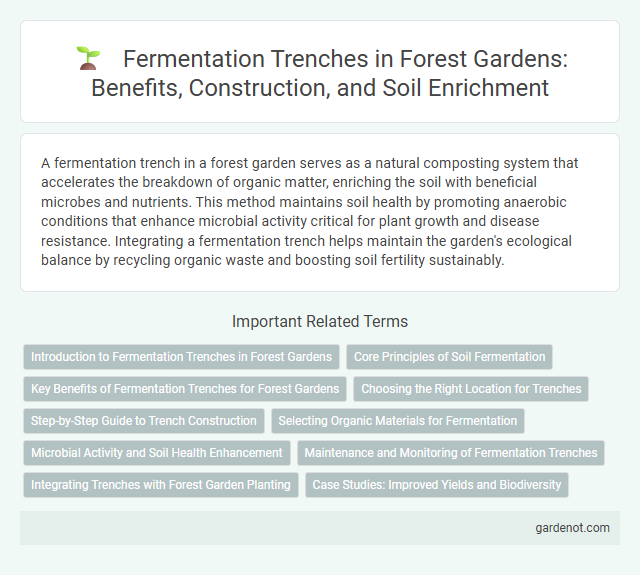A fermentation trench in a forest garden serves as a natural composting system that accelerates the breakdown of organic matter, enriching the soil with beneficial microbes and nutrients. This method maintains soil health by promoting anaerobic conditions that enhance microbial activity critical for plant growth and disease resistance. Integrating a fermentation trench helps maintain the garden's ecological balance by recycling organic waste and boosting soil fertility sustainably.
Introduction to Fermentation Trenches in Forest Gardens
Fermentation trenches in forest gardens serve as specialized pits designed to decompose organic matter rapidly through controlled microbial activity, enriching soil fertility and promoting nutrient cycling. These trenches optimize decomposition by maintaining ideal moisture and aeration conditions, facilitating the breakdown of leaves, branches, and kitchen waste into humus-rich compost. Integrating fermentation trenches enhances plant growth and soil health, supporting the sustainable productivity of forest garden ecosystems.
Core Principles of Soil Fermentation
Fermentation trenches utilize anaerobic microbial processes to enhance soil fertility by breaking down organic matter into bioavailable nutrients. Core principles include maintaining optimal moisture levels, ensuring proper oxygen restriction to promote beneficial microbes, and regulating temperature for efficient microbial activity. This method improves soil structure, increases nutrient cycling, and supports healthy plant growth in forest garden systems.
Key Benefits of Fermentation Trenches for Forest Gardens
Fermentation trenches enhance soil fertility by accelerating the breakdown of organic matter, releasing essential nutrients that promote robust plant growth in forest gardens. They improve microbial activity and soil structure, fostering a healthy ecosystem for diverse plant species. These trenches also aid moisture retention, reducing water stress and supporting sustainable forest garden management.
Choosing the Right Location for Trenches
Selecting the right location for a fermentation trench in a forest garden involves prioritizing well-drained, shaded areas that maintain consistent moisture and stable temperatures. Ideal spots are close to organic material sources to facilitate natural microbial activity and nutrient cycling. Avoid low-lying or excessively wet regions to prevent waterlogging and ensure optimal fermentation conditions.
Step-by-Step Guide to Trench Construction
A fermentation trench in a forest garden is constructed by first selecting a well-drained, shaded location to prevent excessive drying and heat exposure. Begin excavation with dimensions typically around 1 meter wide and 0.5 meters deep, ensuring smooth walls for optimal microbial activity. Line the trench base with organic materials like straw or leaves to facilitate fermentation, then add layers of green and brown biomass, maintaining moisture and proper aeration throughout the process.
Selecting Organic Materials for Fermentation
Selecting organic materials for fermentation in a forest garden involves choosing high-carbon and nitrogen-rich residues such as fallen leaves, wood chips, and green prunings to optimize microbial activity. Balanced ratios of browns (carbon sources) and greens (nitrogen sources) enhance the breakdown process, promoting nutrient release for soil enrichment. Avoiding chemically treated or diseased plant materials ensures healthy fermentation and prevents contamination.
Microbial Activity and Soil Health Enhancement
Fermentation trenches in forest gardens serve as hotspots for microbial activity, promoting the breakdown of organic matter and releasing essential nutrients into the soil. This enhanced microbial diversity accelerates nutrient cycling, improving soil structure and fertility. Increased microbial presence also suppresses soil pathogens, contributing to long-term soil health and plant vigor.
Maintenance and Monitoring of Fermentation Trenches
Regular maintenance of fermentation trenches involves clearing debris, managing moisture levels, and inspecting structural integrity to ensure optimal microbial activity. Monitoring includes tracking temperature, pH, and oxygen levels to maintain the ideal environment for fermentation processes. Consistent oversight prevents contamination and supports healthy nutrient cycling within forest garden systems.
Integrating Trenches with Forest Garden Planting
Fermentation trenches enhance soil health and nutrient cycling within forest gardens by creating microhabitats that support beneficial microbes and fungi. Integrating trenches strategically beneath tree canopies and alongside perennial plants optimizes moisture retention and organic matter decomposition, accelerating nutrient availability. Utilizing locally sourced organic waste in these trenches promotes sustainable soil enrichment, fostering resilient and productive forest garden ecosystems.
Case Studies: Improved Yields and Biodiversity
Fermentation trenches in forest gardens have demonstrated significant improvements in crop yields and biodiversity by enhancing soil microbial activity and nutrient cycling. Case studies in Southeast Asia report up to 30% increase in fruit tree productivity and a notable rise in beneficial insect populations within trench-treated areas. This sustainable technique promotes a balanced ecosystem, supporting both plant health and environmental resilience.
Fermentation trench Infographic

 gardenot.com
gardenot.com